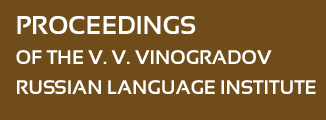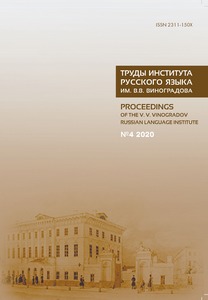WORD-FORMATION AND NOMINATIVE POTENTIAL OF THE PLURAL IN RUSSIAN DIALECTS
Abstract:
The article consists of two parts, different in their content, but in each of them we consider language processes based on a special view of plurality in the dialect speakers’ picture of the world, which takes into account not only quantitative plurality, opposed to singularity, but also additional meanings, which are manifested in dialects more vividly than in the literary language, e. g. collectivity, intensity, temporal and spatial aspects, etc.
In the first part of the article the authors consider dialect models based on the data of the Arkhangelsk regional dictionary. These dialect models, according to which adverbs are formed, can be characterized as productive models in dialects, motivated by nouns with the prefi x в- and suffi xes -ах/-ях, where the suffi x is homonymous to inflections of the plural (such as вблизях, ввозах, вволюшках), as well as models with formants на-...-ах (such as напередах, наподхватках, нарассветках). The abundance of ad verbs that genetically go back to the forms of plural are related to semantics of the plural, expressing in Russian dialects not just quantitative multiplicity, but various kinds of additional shades.
In the second part of the article, using the materials of dialect dictionaries, the a uthors analyze the nouns pluralia tantum, based on the semantics of the plural as well. Although the dialect nominations are distributed in the same groups as the words of the literary language, their “content” is different. E. g., the group denoting time periods, rituals and holidays, insignifi cant in the standard language, is large in dialects, since the number of participants, the annual repetition of rituals and rites contributed to the fact that the names were used in the plural: девятины ‘the ninth day after death’, поминальницы ‘parental memorial days’, назьмы ‘collective assistance in manure re moval’, глядины ‘bride’s looks’, дары ‘pre-wedding gifts from the groom and his fa mily to the bride’, Иваны-купалы, Акули–задери хвосты, Аграфены-лютые корни, etc. The considered productivity of plural in the formation of adverbs and nouns plu ralia tantum is explained by the fact that in the dialect picture of the world, the mean ing of multiplicity is accompanied, among other things, by the values of collectivity, generality and intensity.


